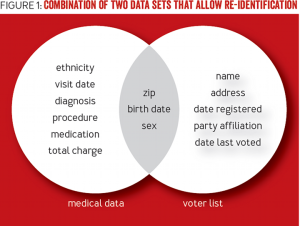This week we highlight 3 writers discussing timely subjects in media tech law: Sandy Botkin writing about zombie cookies and targeted advertising, Geoffrey Fowler writing about the new world of phishing and “phishermen” (yes, that’s a thing), and Justin Giovannettone and Christina Von der Ahe writing about nonsolicitation agreements and social media law.
FTC vs Turn, Inc.: Zombie Hunters
Sandy Botkin, writing on TaxBot Blog, reports amusingly on the FTC’s December 2016 settlement with digital advertising data provider Turn, Inc., stemming from an enforcement action against Turn for violating Turn’s own consumer privacy policy. Botkin used the analogy of a human zombie attack to illustrate the effect of actions Turn took to end-run around user actions to block targeted advertising on websites and apps.
According to the FTC in its complaint, Turn’s participation in Verizon Wireless’ tracking header program – attaching unique IDs to all unencrypted mobile internet traffic for Verizon subscribers – enabled turn to re-associate the Verizon subscriber with his or her use history. By so doing, according to Botkin, this further enabled Turn to “recreate[] cookies that consumers had previously deleted.” Or better yet: “Put another way, even when people used the tech equivalent of kerosene and machetes [to thwart zombies], Turn created zombies out of consumers’ deleted cookies.”
What we like: We like Botkin’s zombie analogy, although not because we like zombies. We don’t. Like. Zombies. But we do think it’s a clever explanatory tool for an otherwise arcane issue.
* * *
Your Biggest Online Security Risk Is You
Geoffrey Fowler writes in The Wall Street Journal (here ($), with an even fuller version of the story available here via Dow Jones Newswires) about the latest in the world of phishing, that large category of online scams that, one way or another, has the common goals of accessing your data, your money or your life, or someone else’s who might be accessed through your unsuspecting gateway.
“If you’re sure you already know all about them, think again. Those grammatically challenged emails from overseas ‘pharmacies’ and Nigerian ‘princes’ are yesterday’s news. They’ve been replaced by techniques so insidious, they could leave any of us feeling like a sucker.”
Oren Falkowitz of Area 1 Security told Fowler that about 97% of all cyberattacks start with phishing. Phishing is a big deal.
Fowler writes of the constantly increasing sophistication of “phishermen” – yes, that’s a term – weakening the effectiveness of old common-sense precautions:
In the past, typos, odd graphics or weird email addresses gave away phishing messages, but now, it’s fairly easy for evildoers to spoof an email address or copy a design perfectly. Another old giveaway was the misfit web address at the top of your browser, along with the lack of a secure lock icon. But now, phishing campaigns sometimes run on secure websites, and confuse things with really long addresses, says James Pleger, security director at RiskIQ, which tracked 58 million phishing incidents in 2016.
What we like: Fowler is helpful with advice about newer precautions, including keeping web browser security features updated and employing 2-factor authentication wherever possible. We also like his admission of his own past victim-hood to phishing, via a malware attack. He’s not overly cheery about the prospects of stopping the bad guys, but he does give confidence to people willing to take a few extra regular precautions.
* * *
Don’t Friend My Friends: Nonsolicitation Agreements Should Account for Social Media Strategies
This is an employment story about former employees who signed agreements with their former employers restricting their solicitations of customers of their former employers. In the traditional nonsolicitation context, it wasn’t that hard to tell when a former employee went about trying to poach his or her former company’s business. Things have become trickier in the age of social media, when “friend”-ing, “like”-ing, or “following” a contact on Facebook, Twitter, Instagram or LinkedIn might or might not suggest nefarious related behavior.
Justin Giovannettone and Christina Von der Ahe of Orrick’s “Trade Secrets Watch” survey a nice representative handful of recent cases from federal and state courts on just such questions.
In one case, the former employee – now working for a competitor of his former employer – remained linked via LinkedIn with connections he made while at his former company. His subsequent action in inviting his contacts to “check out” his new employer’s updated website drew a lawsuit for violating his nonsolicitation. For various reasons, the lawsuit failed, but of most interest was Giovannettone and Von der Ahe’s comment that “The court also noted that the former employer did not request or require the former employee to “unlink” with its customers after he left and, in fact, did not discuss his LinkedIn account with him at all.”
What we like: Giovannettone and Von der Ahe point out the inconsistencies in court opinions on this subject and, therefore, smartly recognize the takeaway for employers, namely to be specific about what’s expected of former employees. That may seem obvious, but for me it was surprising to learn that an employer could potentially – and enforceably – prevent a former employee from “friend”-ing on Facebook.
Read More


